|
The Ford
Model T
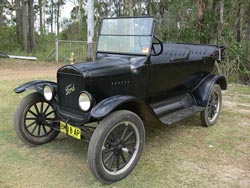 |
|
Manufacturer |
Ford Motor Company |
|
Production |
19081927 |
|
Assembly |
Detroit, US;
Highland Park, US;
Minneapolis, US
Buenos Aires, Argentina;
Geelong, Australia;
Sγo Bernardo do Campo, Brazil;
Toronto, Ontario, Canada;
Walkerville, Ontario;
Copenhagen, Denmark;
Manchester, England;
Berlin, Germany;
Cork, Ireland |
|
Predecessor |
Ford Model S |
|
Successor |
Ford Model A |
|
Class |
Full-size Ford, economy car |
|
Body style |
2-door touring (190911)
3-door touring (19121925)
4-door touring (19261927)
no door roadster (190911)
1-door roadster(19121925)
2-door roadster (19261927)
roadster pickup (19251927)
2-door coupι (19091912, 19171927)
2-door Coupelet (191517)
Town car (19091918)
C-cab wagon (1912)
2-(Center)door sedan (19151923)
2-door sedan (19241927)
4-door sedan (19231927)
Separate chassis were available all years for independent coachbuilders |
|
Layout |
FR layout |
|
Engine |
177 C.I.D. (2.9 L) 20 hp I4 |
|
Transmission |
2-speed planetary gear |
|
Wheelbase |
99.0 in (2,515 mm) |
|
Length |
134 in (3,404 mm) |
|
Curb weight |
1,200 pounds (540 kg) |
|
Designer |
Henry Ford, Childe Harold Wills, Joseph A. Galamb and Eugene Farkas |
|
|
A major innovation brought
about by Henry Ford was the assembly line. He
realized that it would be much simpler, more practical,
and quicker if , when assembling the vehicle, the
workers could draw the various components from suitable
containers placed beside the production line, rather
than going to the various storerooms for them, which
meant they had constantly to by moving from place to
place. In this way he managed to reduce the assembly
time from 12 hours to a car coming off the line every 40
seconds.
Background
The
Ford Model T (colloquially known as the
Tin Lizzie, Flivver, T‑Model Ford, or
T) is an automobile that was produced by Henry
Ford's Ford Motor Company from September 1908 to May
1927. It is generally regarded as the first affordable
automobile, the car that opened travel to the common
middle-class American; some of this was because of
Ford's innovations, including assembly line production
instead of individual hand crafting. The Ford Model T
was named the world's most influential car of the 20th
century in an international poll.
The Model T set 1908 as the
historic year that the automobile became popular. The
first production Model T was produced on August 12, 1908
and left the factory on September 27, 1908, at the
Piquette Plant in Detroit, Michigan. On May 26, 1927,
Henry Ford watched the 15 millionth Model T Ford roll
off the assembly line at his factory in Highland Park,
Michigan.
There were several cars
produced or prototyped by Henry Ford from the founding
of the company in 1903 until the Model T came along.
Although he started with the Model A, there were not 19
production models (A through T); some were only
prototypes. The production model immediately before the
Model T was the Model S, an upgraded version of the
company's largest success to that point, the Model N.
The follow-up was the Ford Model A and not the Model U.
Company publicity said this was because the new car was
such a departure from the old that Henry wanted to start
all over again with the letter A. The Model T was the
first automobile mass produced on moving assembly lines
with completely interchangeable parts, marketed to the
middle class. Henry Ford said of the vehicle:
"I will build a car for the
great multitude. It will be large enough for the
family, but small enough for the individual to run
and care for. It will be constructed of the best
materials, by the best men to be hired, after the
simplest designs that modern engineering can devise.
But it will be so low in price that no man making a
good salary will be unable to own one and enjoy
with his family the blessing of hours of pleasure in
God's great open spaces."
Why the Model T was so important
Before the Model T, most cars cost
lots of money. Only people with lots of money could
afford them. Even Ford's cars before the Model T cost a
lot of money. The model t went for around $980. A car
built in 1903 called the Oldsmobile Curved Dash was very
easy to buy, but was a very simple and slow car that was
more like a buggy than a car.
The man who owned the company, Henry Ford, heard about
meat being packed on an assembly line, which moved meat
from worker to worker so that the meat could be cut up.
No one had ever thought to use an assembly line to put
cars together. Ford knew that if he built his cars on an
assembly line instead of one at a time like other cars,
he could make a car that anyone could afford and would
be built like cars that cost more money. He also knew
that he could pay his workers lots more money.
The Ford Model T car was designed by Henry Ford, Childe
Harolde Wills and two Hungarian men named Jσzsef Galamb
and Eugene Farkas. The Model T had a 177 cubic inch (2.9
L) four-cylinder engine producing 20 horsepower (15 kW)
for a top speed of 45 miles per hour (72 km/h). The
engine had side valves and three main bearings. Fuel
economy was 14 to 21 miles per gallon (6 to 9 km/l), an
excellent number even today.
In the the Beginning
Ford began building the Model T in
his Piquette factory on October 6, 1908 as a 1909 model.
Workers from all over the world wanted to work for Ford
because of the good pay. Workers could even save their
money for a Model T of their own. The price of the Model
T dropped over the years, making it even easier to buy.
Work began at one end of the assembly line, starting
with an empty chassis. From there, the chassis moved
slowly down the assembly line. Workers on the assembly
line added parts to the chassis. Before long, a new
Model T rolled off the other end of the line. Different
body styles were available, even a truck, or Model TT.
At first, the only color available was black. Black
paint was used because it was cheaper than other paints
and Ford was obsessed with increasing profit. As car
paint got better over the years, Ford began offering
other colors. The time it took a chassis to become a
finished car was over twelve hours when the first Model
T's were built. By the time the last Model T came off of
the line, Ford had so many auto plants it was making one
car every 40 seconds!
Even though the Model T sold for little money, Ford used
the best materials he could buy to make his car. Most
roads in the Model T's day were dirt, gravel or even
mud. That meant the Model T had to be very strong, and
it was. The wheels and tires were very tall and skinny
so that they could sink into mud roads and not get
stuck. It was also very simple.
Ford in Australia
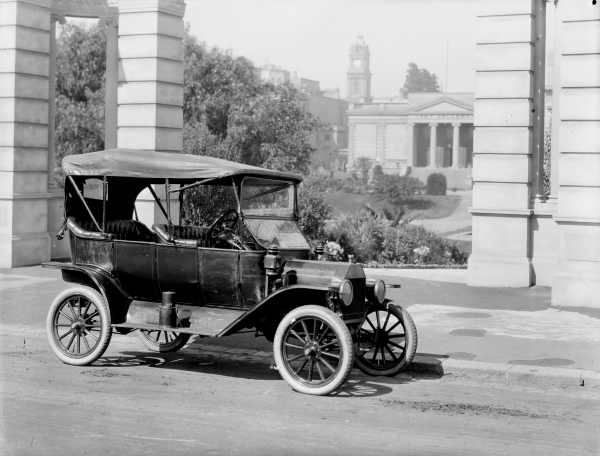
On March 31, 1925, Ford announced that Geelong, was to
be the Australian headquarters. The first
Australian-built Ford was a Model T that came off an
improvised production line in a disused Geelong
woolstore in June 1925, while work started on a factory
in the nearby suburb of Norlane. In 1928 the factory
switched to the Model A and was followed by the Ford V8
in 1932.
In 1934 the company released the world's first coupe
utility. The inventor was Ford engineer Lewis Bandt.
During the Depression, banks would not extend credit to
farmers to purchase passenger cars- in the belief they
were unnecessary luxuries. However, they would lend
money for the purchase of "working" vehicles. The coupe
utility fulfilled the need of farmers to have a
workhorse which could also be used "to take the wife to
church on Sunday and to the market on Monday".
In 1956 the company bought a large tract of land in the
northern Melbourne suburb of Broadmeadows, and in July
1961 announced that the new Melbourne factory would
become the company headquarters.
Characteristics
The Ford Model T car was designed
by Childe Harold Wills and two Hungarian immigrants,
Joseph A. Galamb and Eugene Farkas. Henry Love, C. J.
Smith, Gus Degner and Peter E. Martin were also part of
the team. Production of the Model T began in the third
quarter of 1908. Collectors today sometimes classify
Model Ts by build years and refer to these as "model
years", thus labeling the first Model Ts as 1909 models.
This is a retroactive classification scheme; the concept
of model years as we conceive it today did not exist at
the time. The nominal model designation was "Model T",
although design revisions did occur during the car's two
decades of production.
Engine and means of starting
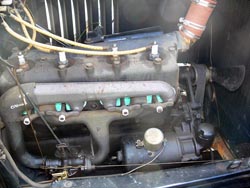 The
Model T had a 177-cubic-inch (2.9 L) front-mounted
inline four-cylinder en bloc engine (that is, all
four cylinders in one block, as common now, rather than
in individual castings, as common then) producing 20 hp
(15 kW) for a top speed of 4045 mph (6472 km/h). The
Model T four-cylinder side valve engine was first in the
world with a detachable head, making service like valve
jobs easier. According to Ford Motor Company, the Model
T had fuel economy on the order of 1321 mpg-US
(1625 mpg-imp; 1811
L/100 km). The engine was capable of running on petrol,
kerosene, or ethanol, although the decreasing cost of
petrol and the later introduction of Prohibition made
ethanol an impractical fuel. The
Model T had a 177-cubic-inch (2.9 L) front-mounted
inline four-cylinder en bloc engine (that is, all
four cylinders in one block, as common now, rather than
in individual castings, as common then) producing 20 hp
(15 kW) for a top speed of 4045 mph (6472 km/h). The
Model T four-cylinder side valve engine was first in the
world with a detachable head, making service like valve
jobs easier. According to Ford Motor Company, the Model
T had fuel economy on the order of 1321 mpg-US
(1625 mpg-imp; 1811
L/100 km). The engine was capable of running on petrol,
kerosene, or ethanol, although the decreasing cost of
petrol and the later introduction of Prohibition made
ethanol an impractical fuel.
A flywheel magneto was an electrical generator that
produced the high voltage necessary to produce a spark
to initiate combustion. This voltage was distributed by
the timer (analogous to a distributor in a modern
vehicle) to one of the four trembler coils, one for each
cylinder. The coil created a high voltage current,
directly connected to the spark plug in the cylinder.
Ignition timing was adjusted manually by using the spark
advance lever mounted on the steering column which
rotated the timer. A battery could be used for starting
current: at hand-cranking speed, the magneto did not
always produce sufficient current (a starting battery
was not standard equipment until sometime in 1926,
though all T's had a bat position on the coil box
switch). A certain amount of skill and experience was
required to find the optimal timing for any speed and
load. When electric headlights were introduced in 1915,
the magneto was upgraded to supply power for the lights
and horn. In keeping with the goal of ultimate
reliability and simplicity, the trembler coil and
magneto ignition system was retained even after the car
became equipped with a generator and battery for
electric starting and lighting. Most cars sold after
1919 were equipped with electric starting, which was
engaged by a small round button on the floor.
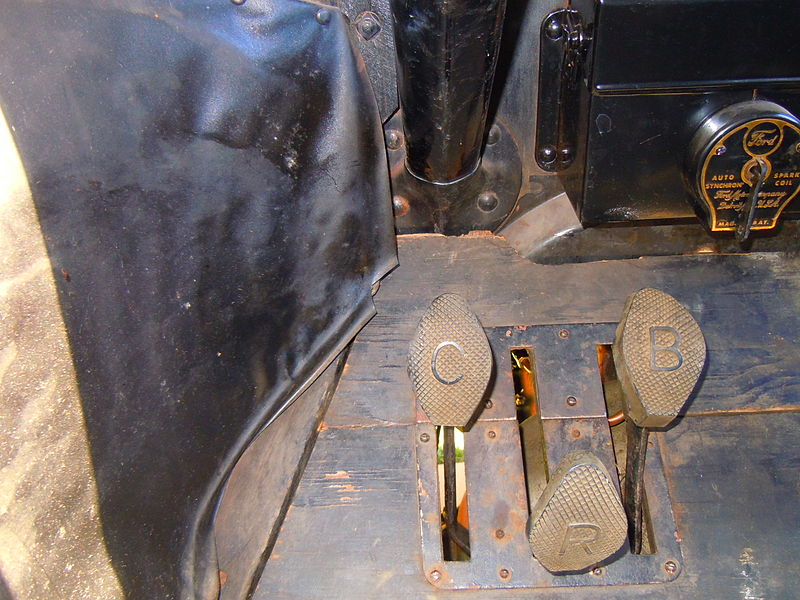 Before
starting a Model T with the hand crank, the spark had to
be manually retarded or the engine might "kick back".
The crank handle was cupped in the palm, rather than
grabbed with the thumb under the top of the handle, so
that if the engine did kick back, the rapid reverse
motion of the crank would throw the hand away from the
handle, rather than violently twisting the wrist or
breaking the thumb. Most Model T Fords had the choke
operated by a wire emerging from the bottom of the
radiator where it could be operated with the left hand.
This was used to prime the engine while cranking the
engine slowly then starting the engine with the left
hand with a rapid pull of the crank handle. The car only
had to be cranked half a turn for it to successfully
start. This "quick start" is because of the engine's
small displacement and low compression. Before
starting a Model T with the hand crank, the spark had to
be manually retarded or the engine might "kick back".
The crank handle was cupped in the palm, rather than
grabbed with the thumb under the top of the handle, so
that if the engine did kick back, the rapid reverse
motion of the crank would throw the hand away from the
handle, rather than violently twisting the wrist or
breaking the thumb. Most Model T Fords had the choke
operated by a wire emerging from the bottom of the
radiator where it could be operated with the left hand.
This was used to prime the engine while cranking the
engine slowly then starting the engine with the left
hand with a rapid pull of the crank handle. The car only
had to be cranked half a turn for it to successfully
start. This "quick start" is because of the engine's
small displacement and low compression.
The car's 10 US gal (38 l;
8 imp gal) fuel tank was mounted to the frame beneath
the front seat; one variant had the carburetor (a Holley
Model G) modified to run on ethyl alcohol, to be made at
home by the self-reliant farmer. Because Ford relied on
gravity to feed fuel to the carburetor rather than a
fuel pump, a Model T could not climb a steep hill when
the fuel level was low. The immediate solution was to
climb steep hills in reverse. In 1926, the fuel tank was
moved forward to under the cowl on most models.
Early on, the engine blocks
were to be produced by the Lakeside Foundry on St. Jean
in Detroit. Ford cancelled the deal before many were
produced.
The first few hundred Model Ts
had a water pump, but it was eliminated early in
production. Ford opted for a cheaper and more reliable
thermo-syphon system. Hot water, being less dense, would
rise to the top of the engine and up into the top of the
radiator, descending to the bottom as it cooled, and
back into the engine. This was the direction of water
flow in most cars which did have water pumps, until the
introduction of crossflow radiator designs. Many types
of water pumps were available as aftermarket
accessories.
Transmission and drive train
The Model T was a rear-wheel
drive vehicle. Its transmission was a planetary gear
type billed as "three speed". In today's terms it would
be considered a two-speed, because one of the three
speeds was reverse.
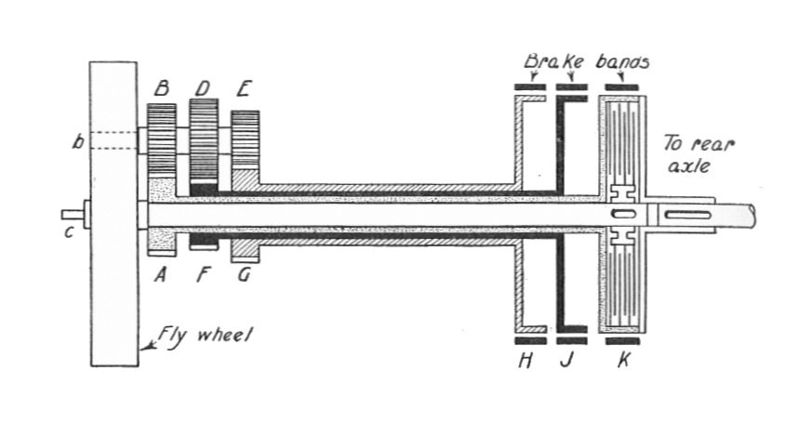 The
Model T's transmission was controlled with three foot
pedals and a lever that was mounted to the road side of
the driver's seat. The throttle was controlled with a
lever on the steering wheel. The left pedal was used to
engage the gear. With the handbrake in either the mid
position or fully forward and the pedal pressed and held
forward the car entered low gear. When held in an
intermediate position the car was in neutral, a state
that could also be achieved by pulling the floor-mounted
lever to an upright position. If the lever was pushed
forward and the driver took his foot off the left pedal,
the Model T entered high gear, but only when the
handbrake lever was fully forward. The car could thus
cruise without the driver having to press any of the
pedals. There was no separate clutch pedal. The
Model T's transmission was controlled with three foot
pedals and a lever that was mounted to the road side of
the driver's seat. The throttle was controlled with a
lever on the steering wheel. The left pedal was used to
engage the gear. With the handbrake in either the mid
position or fully forward and the pedal pressed and held
forward the car entered low gear. When held in an
intermediate position the car was in neutral, a state
that could also be achieved by pulling the floor-mounted
lever to an upright position. If the lever was pushed
forward and the driver took his foot off the left pedal,
the Model T entered high gear, but only when the
handbrake lever was fully forward. The car could thus
cruise without the driver having to press any of the
pedals. There was no separate clutch pedal.
The middle pedal was used to
engage reverse gear, and the right pedal operated the
transmission brake. The floor lever also controlled the
parking brake, which was activated by pulling the lever
all the way back. This doubled as an emergency brake.
Although it was uncommon, the
drive bands could fall out of adjustment, allowing the
car to creep, particularly when cold, adding another
hazard to attempting to start the car: a person cranking
the engine could be forced backward while still holding
the crank as the car crept forward, although it was
nominally in neutral. As the car utilized a wet clutch,
this condition could also occur in cold weather, where
the thickened oil prevents the clutch discs from
slipping freely. Power reached the differential through
a single universal joint attached to a torque tube which
drove the rear axle; some models (typically trucks, but
available for cars as well) could be equipped with an
optional two-speed Ruckstell rear axle shifted by a
floor-mounted lever which provided an underdrive gear
for easier hill climbing. All gears were vanadium steel
running in an oil bath.
Suspension and wheels
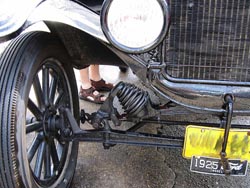 Model
T suspension employed a transversely mounted
semi-elliptical spring for each of the front and rear
axles, which was a solid beam axle, not an independent
suspension, which still allowed a great deal of wheel
movement to cope with the dirt roads of the time. Model
T suspension employed a transversely mounted
semi-elliptical spring for each of the front and rear
axles, which was a solid beam axle, not an independent
suspension, which still allowed a great deal of wheel
movement to cope with the dirt roads of the time.
The front axle was drop forged
as a single piece of vanadium steel. Ford twisted many
axles eight times and sent them to dealers to be put on
display to demonstrate its superiority. The Model T did
not have a modern service brake. The right foot pedal
applied a band around a drum in the transmission, thus
stopping the rear wheels from turning. The previously
mentioned parking brake lever operated band brakes on
the outside of the rear brake drums.
Wheels were wooden artillery
wheels, with steel welded-spoke wheels available in 1926
and 1927.
Tires were pneumatic clincher
type, 30 in (76 cm) in diameter, 3.5 in (8.9 cm) wide in
the rear, 3 in (7.5 cm) wide in the front. Clinchers
needed much higher pressure than today's tires,
typically 60 psi (410 kPa), to prevent them from leaving
the rim at speed. Horseshoe nails on the roads, together
with the high pressure, made flat tires a common
problem.
Balloon tires became available
in 1925. They were 21 Χ 4.5 in (53 Χ 11 cm) all around.
Balloon tires were closer in design to today's tires,
with steel wires reinforcing the tire bead, making lower
pressure possible typically 35 psi (240 kPa) giving
a softer ride. The old nomenclature for tire size
changed from measuring the outer diameter to measuring
the rim diameter so 21 in (530 mm) (rim diameter) Χ
4.5 in (110 mm) (tire width) wheels has about the same
outer diameter as 30 in (76 cm) clincher tires. All
tires in this time period used an inner tube to hold the
pressurized air; "tubeless" tires were not generally in
use until much later.
Wheelbase was 99 inches
(250 cm); while standard tread width was 56 in (142 cm),
60 in (152 cm) tread could be obtained on special order,
"for Southern roads".
Design changes
Up until 1916, early Ts had a
brass radiator and headlights. The horn and numerous
small parts were also brass. Many of the early cars were
open-bodied touring cars and runabouts, these being
cheaper to make than closed cars. Prior to the 1911
model year (when front doors were added to the touring
model), US - made open cars did not have an opening door
for the driver. Later models included closed cars
(introduced in 1915), sedans, coupes and trucks. The
chassis was available so trucks could be built to suit.
Ford also developed some truck bodies for this chassis,
designated the Model TT. The headlights were originally
acetylene lamps made of brass (commonly using
Prest-O-Lite tanks), but eventually the car gained
electric lights after 1910, initially powered from the
magneto until the electrical system was upgraded to a
battery, generator and starter motor, when lighting
power was switched to the battery source.
The Model T production system,
the epitome of Fordism, is famous for representing the
rigidity of early mass production systems that were
wildly successful at achieving efficiency but that could
accommodate changes in product design only with great
difficulty and resistance. The story is more
complicated; there were few major, publicly visible
changes throughout the life of the model, but there were
many smaller changes. Most were driven by design for
manufacturability considerations, but styling and new
features also played more of a role than commonly
realized. In fact, one of the problems for the company
regarding design changes was the T's reputation for not
changing and being "already correct", which Henry Ford
enjoyed and which was a selling point for many
customers, which made it risky to admit any changes
actually were happening. (The idea of simply refining a
design without making radical visible changes would
resurface, and score even greater production success,
with the VW Type 1.)
Cylinder Head Changes
|
Date of Change |
Factory Number |
Change |
|
12-11-08 |
T401BR |
Adopte1d |
|
12-29-08 |
T401BR |
Changed screw hole
from 25/64 to 29/64&q2ot; |
|
03-23-09 |
T401BR |
Added for use after 1st 250
cars |
|
12-06-20 |
T401BR |
Obsolete - "all stock
scrapped in June" |
|
02-01-09 |
T401C |
Adopted
(Thermo-syphon) |
|
02-14-10 |
T401C |
Removed spotting boss
from rear end |
|
03-14-11 |
T401C |
Increased compression
space by 3/32" |
|
07-22-11 |
T401C |
Added spotting boss to
rear end |
|
04-16-12 |
T401C |
Added "Made in U.S.A." |
|
06-10-12 |
T401C |
Added bosses between
combustion chamber and water jacket for 1/8"
pipe taps on left side of head. |
|
11-26-12 |
T401C |
Removed 1/8" pipe taps
for priming. Bosses remain. |
|
07-17-14 |
T401C |
Added 3/32 to bottom
of head, increases all top to bottom
dimensions and lowers compression. |
|
05-17-17 |
T401C |
Redesigned High Head
Changes ASAP, Use Up Old Stock. |
|
08-15-17 |
T401C |
Added 3/4" cored hole
between chambers 2 & 3. |
|
02-23-18 |
T401C |
Changed rear locating
boss from 5/8" square to 1/2" |
|
09-25-18 |
T401C |
Reduced height of
combustion chamber 1/16" |
|
01-12-20 |
T401C |
Removed rear locating
boss |
|
05-18-26 |
T401C |
Reduced height of
combustion chamber 3/32" |
|
06-22-26 |
T401C |
Increased height of
combustion chamber 3/32". |
|
10-20-26 |
T401C |
Specified paint with
M-124 |
Colors
By 1918, half of all the cars
in the US were Model T's. However it was a monolithic
bloc; Ford wrote in his autobiography that he told his
management team in 1909 that in the future
"Any
customer can have a car painted any color that he wants
so long as it is black".
However, in the first years of
production from 1908 to 1914, the Model T was not
available in black but rather only grey, green, blue,
and red. Green was available for the touring cars, town
cars, coupes, and Landaulets. Grey was only available
for the town cars, and red only for the touring cars. By
1912, all cars were being painted midnight blue with
black fenders. It was only in 1914 that the "any color
as long as it is black" policy was finally implemented.
It is often stated that Ford suggested the use of black
from 1914 to 1926 due to the cheap cost and durability
of black paint. During the lifetime production of the
Model T, over 30 different types of black paint were
used on various parts of the car. These were formulated
to satisfy the different means of applying the paint to
the various parts, and had distinct drying times,
depending on the part, paint, and method of drying.
Diverse applications in a world not
yet widely paved, motorized, or
electrified
 Read full article
Read full article
 here.
here.
When the Model T was designed
and introduced, the infrastructure of the world was
quite different from today's. Pavement was a rarity
except for sidewalks and a few big-city streets. (The
sense of the term "pavement" as equivalent with
"sidewalk" comes from that era, when streets and roads
were generally dirt (mud during rainy periods) and
sidewalks were a paved way to walk down them without
getting dirty. In fact, this was a motive for
segregating foot traffic from carriage traffic long
before the speed of automobiles provided another
motive.) Agriculture was the occupation of many people.
Power tools were scarce outside factories, as were any
power sources to run them; electrification, like
pavement, was found usually only in larger towns and
cities. Rural electrification and motorized
mechanization were embryonic in North America and
Europe, and nonexistent elsewhere.
Henry Ford oversaw the
requirements and design of the Model T based on the
realities of that world. Consequently, the Model T was
(intentionally) almost as much a tractor and stationary
engine as it was an automobile, that is, a vehicle
dedicated solely to road use. It has always been well
regarded for its all-terrain abilities and ruggedness.
It could travel a rocky, muddy farm lane, ford a shallow
stream, climb a steep hill, and be parked on the other
side to have one of its wheels removed and a pulley
fastened to the hub for a flat belt to drive a bucksaw,
thresher, silo blower, conveyor for filling corn cribs
or haylofts, baler, water pump (for wells, mines, or
swampy farm fields), electrical generator, and countless
other applications. One unique application of the Model
T was shown in the October 1922 issue of Fordson Farmer
magazine. It showed a minister who had transformed his
Model T in to a mobile church, complete with small
organ.
During this era, entire
automobiles (including thousands of Model Ts) were even
hacked apart by their industrious owners and
reconfigured into custom machinery permanently dedicated
to a purpose, such as homemade tractors, ice saws, or
many others. Dozens of aftermarket companies sold prefab
kits to facilitate the T's conversion from car to
tractor. In a world mostly without mechanized
cultivators, Model Ts filled a vacuum. Row-crop tractors
such as the Farmall did not become widespread until the
1930s. Like many popular car engines of the era, the
Model T engine was also used on home-built aircraft
(such as the Pietenpol Sky Scout) and motorboats.
Also, many Model Ts were
converted into vehicles which could travel across heavy
snows with kits on the rear wheels and skis where the
front wheels were located. They were popular for rural
mail delivery for a time. The common name for these
conversions of cars and small trucks was Snowflyers.
These vehicles were extremely popular in the northern
reaches of Canada where factories were set up to produce
them.
Production
Mass production
The knowledge and skills needed
by a factory worker were reduced to 84 areas. When
introduced, the T used the building methods typical at
the time, assembly by hand, and production was small.
Ford's Piquette plant could not keep up with demand for
the Model T, and only 11 cars were built there during
the first full month of production. More and more
machines were used to reduce the complexity within the
84 defined areas. In 1910, after assembling nearly
12,000 Model Ts, Henry Ford moved the company to the new
Highland Park complex.
 As
a result, Ford's cars came off the line in three-minute
intervals, much faster than previous methods, reducing
production time by a factor of eight (requiring 12.5
hours before, 93 minutes afterwards), while using less
manpower. By 1914, the assembly process for the Model T
had been so streamlined it took only 93 minutes to
assemble a car. That year Ford produced more cars than
all other automakers combined. The Model T was a great
commercial success, and by the time Henry made his 10
millionth car, 50 percent of all cars in the world were
Fords. It was so successful that Ford did not purchase
any advertising between 1917 and 1923; more than
15 million Model Ts were manufactured, reaching a rate
of 9,000 to 10,000 cars a day in 1925, or 2 million
annually, more than any other model of its day, at a
price of just $240. Model T production was finally
surpassed by the Volkswagen Beetle on February 17, 1972. As
a result, Ford's cars came off the line in three-minute
intervals, much faster than previous methods, reducing
production time by a factor of eight (requiring 12.5
hours before, 93 minutes afterwards), while using less
manpower. By 1914, the assembly process for the Model T
had been so streamlined it took only 93 minutes to
assemble a car. That year Ford produced more cars than
all other automakers combined. The Model T was a great
commercial success, and by the time Henry made his 10
millionth car, 50 percent of all cars in the world were
Fords. It was so successful that Ford did not purchase
any advertising between 1917 and 1923; more than
15 million Model Ts were manufactured, reaching a rate
of 9,000 to 10,000 cars a day in 1925, or 2 million
annually, more than any other model of its day, at a
price of just $240. Model T production was finally
surpassed by the Volkswagen Beetle on February 17, 1972.
Henry Ford's ideological
approach to Model T design was one of getting it right
and then keeping it the same; he believed the Model T
was all the car a person would, or could, ever need. As
other companies offered comfort and styling advantages,
at competitive prices, the Model T lost market share.
Design changes were not as few as the public perceived,
but the idea of an unchanging model was kept intact.
Eventually, on May 26, 1927, Ford Motor Company ceased
production and began the changeovers required to produce
the Model A.
Model T engines continued to be
produced until August 4, 1941. Almost 170,000 were built
after car production stopped, as replacement engines
were required to service already produced vehicles.
Racers and enthusiasts, forerunners of modern hot
rodders, used the Model T's block to build popular and
cheap racing engines, including Cragar, Navarro, and
famously the Frontenacs ("Fronty Fords") of the
Chevrolet brothers, among many others.
The Model T employed some
advanced technology, for example, its use of vanadium
steel alloy. Its durability was phenomenal, and many
Model Ts and their parts remain in running order nearly
a century later. Although Henry Ford resisted some kinds
of change, he always championed the advancement of
materials engineering, and often mechanical engineering
and industrial engineering.
In 2002, Ford built a final
batch of six Model Ts as part of their 2003 centenary
celebrations. These cars were assembled from remaining
new components and other parts produced from the
original drawings. The last of the six was used for
publicity purposes in the UK.
Although Ford no longer
manufacture parts for the Model T, many parts are still
manufactured through private companies as replicas to
service the thousands of Model T's still in operation
today.
Price
The standard 4-seat open tourer
of 1909 cost $850 (equivalent to $20,709 today), when
competing cars often cost $2,000$3,000 (equivalent to
$48,726$73,089 today); in 1913, the price dropped to
$550 (equivalent to $12,181 today), and $440 in 1915
(equivalent to $9,521 today). Sales were 69,762 in 1911;
170,211 in 1912; 202,667 in 1913; 308,162 in 1914; and
501,462 in 1915. In 1914, an assembly line worker could
buy a Model T with four months' pay.
By the 1920s, the price had
fallen to $290 (equivalent to $3,289 today) because of
increasing efficiencies of assembly line technique and
volume. Henry employed vertical integration of the
industries needed to create his cars.
 View
full price list from 1909 to 1927
here, with some
interesting inflation-adjusted figures. View
full price list from 1909 to 1927
here, with some
interesting inflation-adjusted figures.
Recycling
Henry Ford used wood scraps
from the production of Model T's to create charcoal.
Originally named Ford Charcoal the name was changed to
Kingsford Charcoal
after Ford's relative E. G. Kingsford brokered the
selection of the new charcoal plant site.
First global car
The Ford Model T was the first
automobile built by various countries simultaneously
since they were being produced in Walkerville, Canada
and in Trafford Park, Greater Manchester, England
starting in 1911 and were later assembled in Germany,
Argentina, France, Spain, Denmark, Norway, Belgium,
Brazil, Mexico, and Japan. Ford made use of the
knock-down kit concept almost from the beginning of the
company.
The Aeroford was an English
automobile manufactured in Bayswater, London, from 1920
to 1925. It was a Model T with distinct hood and grille
to make it appear to be a totally different design, what
later would have been called badge engineering. The
Aeroford sold from £288 in 1920, dropping to £168-214 by
1925. It was available as a two-seater, four-seater, or
coupι.
Advertising, marketing, and
packaging
Ford created a massive
publicity machine in Detroit to ensure every newspaper
carried stories and advertisements about the new
product. Ford's network of local dealers made the car
ubiquitous in virtually every city in North America. As
independent dealers, the franchises grew rich and
publicized not just the Ford but the very concept of
automobiling; local motor clubs sprang up to help new
drivers and to explore the countryside. Ford was always
eager to sell to farmers, who looked on the vehicle as a
commercial device to help their business. Sales
skyrocketed several years posted 100% gains on the
previous year.
Sales passed 250,000 in 1914. By 1916, as the price
dropped to $360 for the basic touring car, sales reached
472,000.
Car clubs
Cars built before 1919 are classed as veteran cars and
later models as vintage cars. Today, four main clubs
exist to support the preservation and restoration of
these cars: The Model T Ford Club International, the
Model T Ford Club of America and the combined clubs of
Australia.
With many chapters of clubs
around the world, the Model T Ford Club of Victoria has
a membership with a considerable number of uniquely
Australian cars. (Australia produced its own car bodies
and therefore many differences occurred between the
Australian bodied tourers and the US/Canadian cars). In
the UK, the Model T Ford Register of Great Britain
celebrated its 50th anniversary in 2010.
Many steel Model T parts are
still manufactured today, and even fiberglass replicas
of their distinctive bodies are produced, which are
popular for T-bucket style hot rods (as immortalized in
the Jan and Dean surf music song "Bucket T," which was
later recorded by The Who).
In 2008, there was an around
Australia trip organised by various members of the NSW
portion of the Combined model T clubs of Australia.
Along the trip the members of the club met the likes of
Malcolm Douglas and others. The trip lasted just over 6
months, all of this time the members ate, drank and
slept in their cars that they had modified for the trip.
They left Sydney on 20th, April and made it all the way
to Echuca in Victoria for the 100 year anniversary of
the Model T Ford. People come from all over Australia,
New Zealand and America for the trip to one major city
in Australia that is held every 3 years, they stayed for
a week in Echuca and participated in various activities
organised by the Victoria club and eventually moved on
to go home and see their families back in Sydney on the
9th, October 2008.
In The Music Man by Meredith Wilson Model
T's are blamed for changes in society and the life of
travelling salesmen. "Why it's the Model T Ford made the
trouble, made the people/ Want to go, want to git, want
to git, want to git up and go/ Seven, eight, nine, ten,
twelve, fourteen, twenty-two, twenty-three miles to the
county seat/ Yes Sir Yes Sir/ Who's gonna patronize a
little bitty two-by-four kind of store any more?"
The End of the Model T's Reign
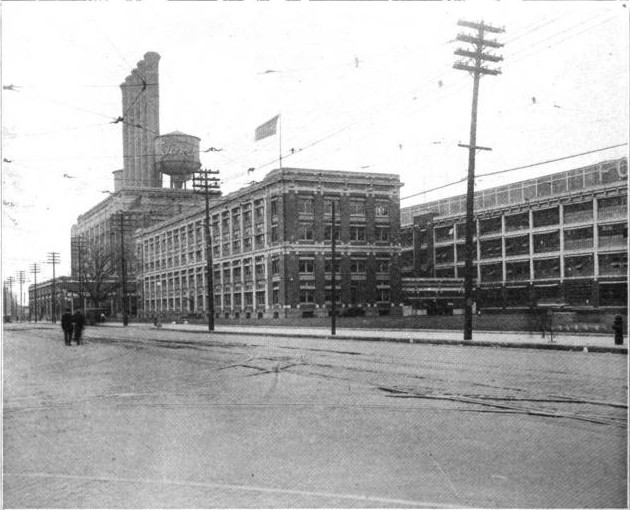 On
June 4, 1924, the ten millionth Model T Ford left the
Highland Park factory, which would remain the main facility for
T production. While the flivver outsold its nearest competitor
by a six-to-one margin that year, its unbridled run was nearing
an unforeseen conclusion. After years of conceding the low end
of the market to Ford, another automaker was setting its sights
on that very sector. On
June 4, 1924, the ten millionth Model T Ford left the
Highland Park factory, which would remain the main facility for
T production. While the flivver outsold its nearest competitor
by a six-to-one margin that year, its unbridled run was nearing
an unforeseen conclusion. After years of conceding the low end
of the market to Ford, another automaker was setting its sights
on that very sector.
At the beginning of the decade,
General Motors was an awkward conglomerate of car
companies and parts suppliers, managed more for the sake
of its whipsaw stock-price than for efficiencies in auto
making. In the middle of the decade, though, a
revitalized GM, under the brilliant leadership of Alfred
P. Sloan, Jr., began to offer inexpensive Chevrolets
with amenities that the Model T lacked. Instead of the
sturdy but antiquated planetary transmission, it had a
smooth three-speed. The market began to shift; price and
value ceased to be paramount factors. Styling and
excitement suddenly counted to the customer. Even though
the Model T cost a mere $290 in the mid-twenties,
dealers clamored for a new Ford that would strike the
fancy of the more demanding and sophisticated consumers.
But Henry Ford refused even to consider replacing his
beloved Model T. Once, while he was away on vacation,
employees built an updated Model T and surprised him
with it on his return. Ford responded by kicking in the
windshield and stomping on the roof. "We got the
message," one of the employees said later, "As far as he
was concerned, the Model T was god and we were to put
away false images." Only one person persisted in warning
him of the impending crisis: his son, Edsel, who had
been installed as president of the Ford Motor Company
during the dividend trial and its aftermath in 1919. It
was the first of many arguments that Edsel would lose,
as the once adoring relationship between the two
deteriorated into distrust and disrespect on Henry's
part and woeful disillusionment on Edsel's.
The Chevrolet continued to take sales from the dour
Model T. By 1926, T sales had plummeted, and the
realities of the marketplace finally convinced Henry
Ford that the end was at hand.
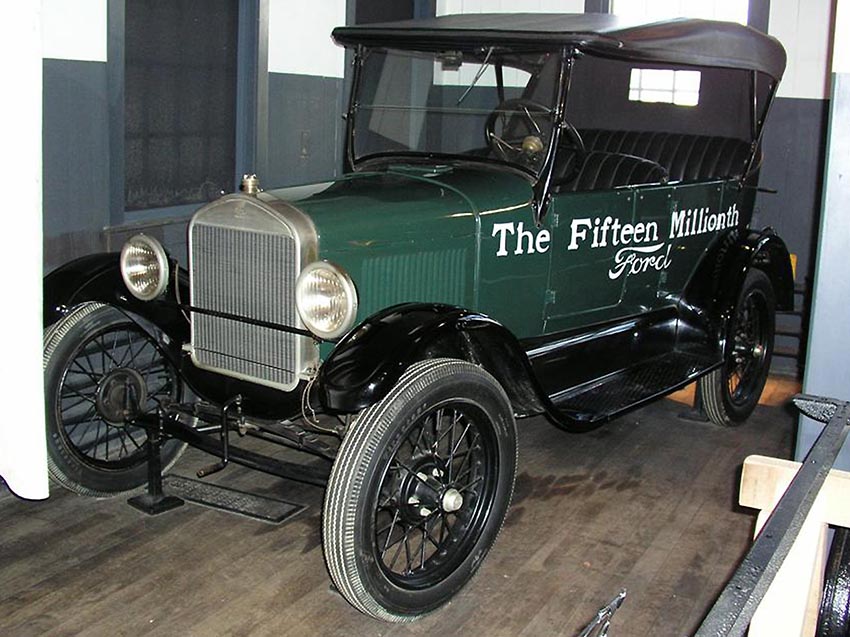 On
May 25, 1927, Ford abruptly announced the end of
production for the Model T, and soon after closed the
Highland Park factory for six months. The shutdown was
not for retooling: there was no new model in the works.
In history's worst case of product planning, Henry sent
the workers home so that he could start to design his
next model. Fortunately, Edsel had been quietly
marshalling sketches from the company's designers, and
he was ready and able to work with his father on
producing plans for the new car, called the Model A. It
was a success from its launch in December 1927, and
placed the company on sound footing again. By the time
it went into production, the River Rouge had become the
main Ford manufacturing facility. On
May 25, 1927, Ford abruptly announced the end of
production for the Model T, and soon after closed the
Highland Park factory for six months. The shutdown was
not for retooling: there was no new model in the works.
In history's worst case of product planning, Henry sent
the workers home so that he could start to design his
next model. Fortunately, Edsel had been quietly
marshalling sketches from the company's designers, and
he was ready and able to work with his father on
producing plans for the new car, called the Model A. It
was a success from its launch in December 1927, and
placed the company on sound footing again. By the time
it went into production, the River Rouge had become the
main Ford manufacturing facility.
When the last Model T rolled off the assembly line, it
was not the end of an era, it was still the very dawn of
the one that the little car had inaugurated. Cars --
more than half of them Model Ts -- pervaded American
culture. They jammed the streets of the great eastern
cities and roamed newly laid roads in southern
California. Adapted to haul everything from mail to
machine guns to coffins to schoolchildren, automobiles
represented an opportunity for change in practically
everything. They also became a crucial factor in
recasting a growing economy. Henry Ford had created a
car for the multitudes and that car had created the
basis of the car culture embraced by every subsequent
generation.
The Ford Motor Company, having survived its own crisis
in the twenties, was one of only forty-four U.S.
automakers left in 1929, out of the hundreds that had
entered the fray since the beginning of the century.
That year, Ford, General Motors, and the newly formed
Chrysler Corporation -- known then and now as the Big
Three -- accounted for 80 percent of the market.
Henry Ford died on April 7, 1947, at the age of
eighty-three, having outlived the Model T by nearly
twenty years. A century has passed since he took the
first car he built for a ride. The world remains in
large part the one set into motion by Henry Ford: a
world in which cars are for everyone. As Will Rogers
said, "It will take a hundred years to tell whether he
helped us or hurt us, but he certainly didn't leave us
where he found us."
Model T Fast Facts
 |
The Model T was introduced
on Oct. 1, 1908. It had a 20-horsepower,
four-cylinder engine, reached a top speed of
about 45 miles per hour, got about 13 to 21
miles per gallon of gasoline and weighed 1,200
pounds. It was the ninth of Henry Ford's
production cars. |
 |
More than 15,000,000 Model
T's were built and sold. A modest ceremony on
May 26, 1927, marked the formal end of Model T
production. |
 |
The first models were
produced at a factory on Piquette Avenue in
Detroit. Beginning in 1910, Model T's were built
at a new Highland Park (Michigan) plant. |
 |
Henry Ford's initiation of
mass production of vehicles on the moving
assembly line led to lower car prices and the $5
workday. |
 |
The car was introduced
with a price tag of $850. The Model T later sold
for as little as $260, without extras, because
of production savings Henry Ford passed on to
customers. |
 |
Henry Ford called the
Model T "the universal car," a low-cost,
reliable vehicle that could be maintained easily
and could successfully travel the poor roads of
the era. |
 |
The Model T came in nine
body styles, all on the same chassis. |
 |
"Lizzie" was one of the
most popular of the dozens of nicknames for the
Model T. |
 |
In 1914, Ford, with 13,000
employees, produced about 300,000 cars while 299
other companies with 66,350 employees produced
about 280,000 vehicles. |
-
John Steele Gordon "10 Moments That Made
American Business," American Heritage,
February/March 2007.
-
Ford also attempted a buy on time
program to aid sales, resembling that of
the German Kdf-Wagen (forerunner of the
Volkswagen Type 1). Ford's plan was not
a success, either.
-
"Joyrides: Car of the Century/ Ford's
Model T, of course".
-
"Chronicle of 1908".
Library.thinkquest.org. Retrieved
2010-11-15.
-
"Henry Ford And The Model T". John Wiley
& Sons. Retrieved February 3, 2011.
-
Early Ford models from the years
19031908; p. 5.
-
Ford 1922,
My life and work (1922), p. 73.
-
Lacey 1986.
-
Reynolds 2009
-
"University students compete to create
21st century Model T". Media.ford.com.
Retrieved January 17, 2011.
-
"History Lesson: Hungary Celebrates the
Ford Model T." Fadaweb.com. Retrieved
2012-01-01
-
Wik 1972.
-
a
b Clymer 1950,
p. 100.
-
"Model T Facts". Media.ford.com
accessdate=November 15, 2010.
-
English, Andrew (July 25, 2008). "Ford
Model T reaches 100". The Telegraph.
Retrieved August 8, 2008.
-
"Ethanol: Introduction". Journey to
Forever. Retrieved August 8, 2008.
-
"Model T Ford Electrical System".
modeltcentral.com. Retrieved October 15,
2009.
-
1926 "Model T Ford Club of America".
-
Clymer 1950, p. 37.
-
Hounshell 1984, pp. 273278.
|
-
Hounshell 1984, p. 275.
-
It would also apply to the Porsche 911.
-
Ford 1922, p. 72.
-
Model T: The car that changed the
world)
-
McCalley 1994
-
Casey, Robert (2008). The Model T A
Centennial History. Baltimore: The
Johns Hopkins University Press. pp. 148.
ISBN 978-0-8018-8850-2.
-
"1926 Ford Model T Ice Saw". Used for
harvesting winter ice from ponds in
Maine.
-
Pripps & Morland 1993, p. 28
-
"Snowflyers Replace Dogs in Frozen
North" Popular Mechanics,
December 1934
-
a
b c
Georgano 1985
-
Martin W. Sandler, Driving Around the
USA: Automobiles in American Life,
Oxford University Press, 2003, p.21
-
Douglas Brinkley, Wheels for the world:
Henry Ford, his company, and a century
of progress, 19032003, Viking, 2003,
p.475
-
My forty years with Ford, Charles E.
Sorensen, David Lanier Lewis, Samuel T.
Williamson, Wayne State University
Press, p.4
-
detnews.com "Michigan History".
-
Ward 1974, p. 1562.
-
History
Page Kingsford products[dead
link]
-
www.auto-historia.com History of Ford
Motors Argentina Retrieved on 19
November 2008.
-
Celebrating the Ford Model T, only 100
years young!, (in Spanish) accessed 22
September 2008.
-
David Culshaw & Peter Horrobin: The
Complete Catalogue of British Cars
18951975. Veloce Publishing plc.
Dorchester (1999). ISBN 1-874105-93-6
-
Lewis 1976, pp. 4159.
|
|

